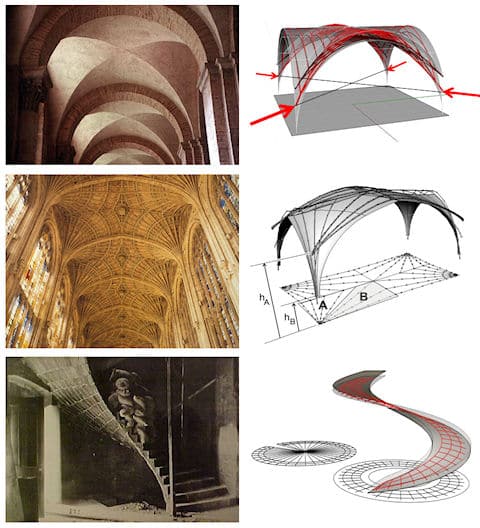This article presents a new methodology for generating compression-only vaulted surfaces and networks. The method finds possible funicular solutions under gravitational loading within a defined envelope. Using projective geometry, duality theory and linear optimization, it provides a graphical and intuitive method, adopting the same advantages of techniques such as graphic statics, but offering a viable extension to fully three-dimensional problems. The proposed method is applicable for the analysis of vaulted historical structures, specifically in unreinforced masonry, as well as the design of new vaulted structures. This paper introduces the method and shows examples of applications in both fields.
Keywords: compression-only structures, unreinforced masonry vaults, funicular analysis, Thrust Network Analysis, reciprocal diagrams, form-finding, lower-bound analysis, structural optimization.
Medieval vault builders created complex forms carefully balanced in compression. The structural properties of these sophisticated forms are still poorly understood because of a lack of appropriate analysis methods, i.e. methods relating stability and form. Understanding the mechanics of these vaulted structures leads to new insights for both analysis and design.
Thrust Line Analysis is a powerful graphical method for calculating the range of lower-bound equilibrium solutions of compression-only systems, such as unreinforced masonry structures (Fig. 1).

It visualizes the stability of these structures and suggests possible collapse mechanisms. Unfortunately, thrust line analysis is primarily suitable for 2-D cases and this limitation has prevented it from being used for the assessment of complex 3-D structures. While numerical methods based on elastic solutions give one possible answer,they no longer suggest better form as was inherentto the more holistic graphical methods There is a real need for tools to better understand and visualize the stability of compression-only structures, such as historic unreinforced masonry structures, as well as design tools that suggest better form. Both problems are related to finding axial force structures in equilibrium acting only in compression or tension. Currently, graphic statics provides a holistic analysis and design tool for twodimensional structures. With today’s availability of powerful virtual 3-D and parametric environments, the following question arises: can a fully threedimensional version of thrust-line analysis provide the same freedom to explore the infinite equilibrium solutions for a certain loading condition?
2. METHODOLOGY
The Thrust-Network Analysis method presented in this paper is inspired by O’Dwyer’s work on funicular analysis of vaulted masonry structures. It is extended by adding the concept of duality between geometry and the in-plane internal forces of networks.
2.1. Reciprocal figures
The duality between the geometry of a network and its internal forces is an old concept, first explained
by Maxwell [4]. He called this relationship reciprocal and defined it as follows: “Two plane figures are reciprocal when they consist of an equal number of lines, so that corresponding lines in the two figures are parallel, and corresponding lines which converge to a point in one figure form a closed polygon in the other.” This means that the equilibrium of a node in the first diagram is represented by a closed polygon in the second diagram and vice versa (Fig. 2). Graphic statics is based on this principle.
Figure 2. The primal grid and dual grid * are related by a reciprocal relationship. The equilibrium of a node in
one of them is guaranteed by a closed polygon in the other and vice versa.
2.2. Assumptions
The proposed method produces funicular (compression-only) solutions for loading conditions where all loads are applied in the same direction, as is the case for gravitational loading. Since the solutions are compression-only this also means that the vaults can never curl back onto themselves, which would demand some elements to go into tension. The resulting three-dimensional networks can represent load paths throughout a structure. There is no constraint on the length of the branches or the planarity of the facets of the solution.
This images present a exemple for the design, engineering, fabrication and construction of an unreinforced stone masonry vault featuring new forms for compression-only structures.


The project is a collaboration between Escobedo Construction and Prof. John Ochsendorf and Philippe Block from MIT. By combining the MIT team’s expertise in three-dimensional equilibrium of complex structures in unreinforced masonry and Escobedo Construction’s expertise in design and construction of stone buildings, we expect to produce a state-of-the-art pavilion.
The vault is being designed using Thrust Network Analysis, a new computational tool developed at MIT for exploring three-dimensional equilibrium structures.
sources: https://equilibriumstone.wordpress.com/
Block’s PhD dissertation
Click here for a presentation with a range of examples and more details on the application of TNA for the analysis of vaulted structures in masonry.





3 comments
The beauty and elegance of stone brought back from ancient history and empowered by contemporary technologies…
Speechless.
je me suis souvent posé la question si c’était la structure ou l’espace (ou la spiritualité [mais non en fait]) qui m’impressionnait dans une cathédrale…
I want to know more about the efforts. Simply beautiful, and inspiring.